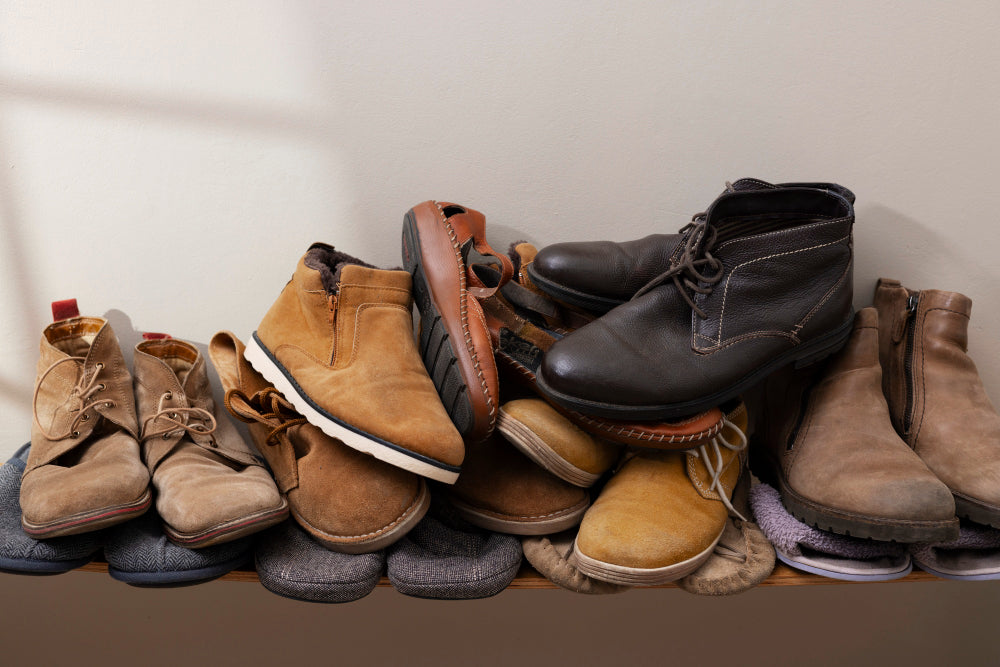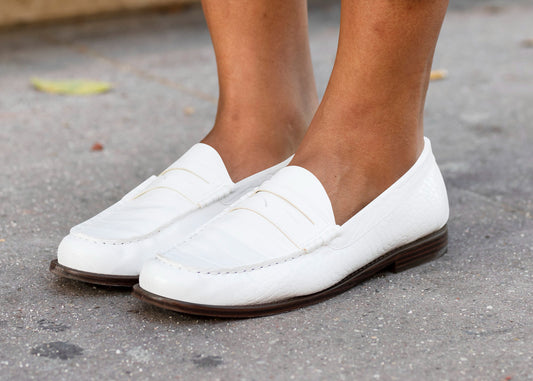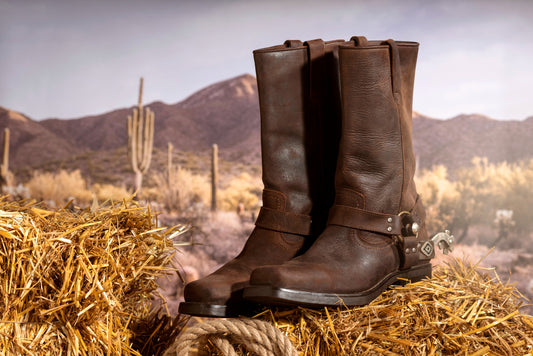How Long Should Shoes Last if You Wear Them Everyday?

According to podiatrists, the shoes we wear on a daily basis need to be replaced every 8 to 12 months.
This replacement cycle might come as a surprise to some, especially those of us who have a favorite pair of sneakers we just can't say goodbye to. When shoes are worn every day, they go through an excessive amount of wear and tear.
Even if your shoes need a little care, they might not keep your feet as protected or comfortable as a new pair would. It's a fact that most shoes begin to lose their structural integrity after about 500 miles of use.
So, whether you're attached to your old trainers or just looking for a guideline on when to invest in a new pair, let's take a look at some factors that can help determine the lifespan of your everyday shoes.
When Do Shoes Becomes Worn?

It doesn't matter whether you're donning a pair of high heels or sticking to athletic shoes, the lifespan of your shoes is dependent on several factors. One rule of thumb, as mentioned earlier, is the 500-mile mark.
However, other signs speak volumes about the need to replace them. For instance, the material (like leather) begins to crack, peel or show noticeable wear and tear.
An equally important aspect to consider is the comfort factor. If the cushion doesn't seem as plush and the insole feels flat, it's a sure sign that your shoes are long past their prime. The heel support may not feel as secure as it once was, which can pose a serious risk to foot health. This is particularly true for high heels, which require a sturdy back to ensure balance.
Daily wear shoes are designed to absorb shock and offer optimum comfort. Signs of deterioration may become obvious when plantar fasciitis flares up or when you feel general discomfort while walking or standing.
Paying attention to these details and following the general rule of thumb can help determine how long should shoes last, ensuring your feet remain healthy and well-supported.
What Factors Affect the Longevity of Your Shoes?
To give you a clearer understanding, let's delve into a range of factors that can affect the longevity of your shoes.
- Your Gait: The way you walk or run can impact how quickly your shoes wear out. For instance, those who tend to walk or run with their weight leaning on the inside or outside of their foot will find that the material across the ball of the foot will begin to wear down sooner.
- Type of Surface: The wear and tear of a shoe on a flat surface compared to rough, uneven terrains will differ significantly. Rough surfaces can lead to excessive wear and creases in the shoe material.
- Activities: Depending on whether you are using walking or running shoes, the deterioration rate may vary. This is because different shoes are specifically designed to play different roles. For example, running shoes are built to endure more intense strain and might degrade faster when used for daily activities.
- Weight: The heavier you are, the more pressure you put on your shoes, which might lead to a quicker breakdown of the shoe structure.
- Temperature: Extremely cold or hot weather can affect the materials of your shoes, potentially shortening their lifespan.
- Frequency of Use: Worn out shoes are often the result of frequent use. Shoes need time to air out and regain their shape, hence wearing the same pair every day can speed up the wear process.
- Foot Pain: If you start experiencing foot pain, this could be a sign that your shoes are not offering enough support or cushioning anymore.
These factors can help identify when it's time to replace a beloved pair of shoes. It's critical to prioritize foot health over retaining worn-out footwear.
A seemingly insignificant factor like the crease in a shoe can cause discomfort and foot pain if not addressed in time.
How Often Should You Replace Your Shoes?
Now, let's get back to the question: how long do shoes last if you wear them every day? Generally, it depends on several factors as discussed above.
However, here are some general guidelines to keep in mind:
Running Shoes
Running shoes might require more frequent replacement compared to other types of footwear. Podiatrists generally recommend that running shoes should be replaced every 300 to 500 miles. However, this range can depend on the runner's weight, running style, and the surfaces they run on. The midsole of the shoe, which provides the cushioning and stability, often wears out before the outsole, leading to a loss of comfort and support.
Moreover, unlike work shoes where the frequency of replacement might vary based on material and design, it is a good rule of thumb to replace your running shoes every three months if you are regularly active. Interestingly, shoe size also plays a role in determining the lifespan of your shoes. Larger sizes experience more wear and tear and may need replacing sooner.
Leather Shoes
Leather shoes or dress shoes count as another category where you should replace your shoes every 6 to 12 months, depending on their quality and walking frequency which wears out the soles. Good maintenance can stretch their lifespan. When shoes reach eye level, visually inspect them for signs of wear and tear. This is likely the time to replace them.
Walking Shoes
If you have a footwear that is mainly used for walking, it's crucial to pay attention to their wear and tear as well. Generally, walking shoes should be replaced every 300 to 500 miles. If you walk briskly for 30 minutes a day, five days a week, you will clock in approximately 3.5 to 5 miles per week depending on your speed. This translates to roughly 180 to 260 miles per year.
Therefore, you should typically replace your walking shoes every six to 12 months. Just as with other types of shoes, always be aware of any discomfort, aches, or pains in your feet when you wear your shoes, as these can be indications that it's time for a new pair.
Athletic Shoes
Athletic shoes, encompassing footwear for sports like tennis, basketball, or soccer, have their own guidelines for replacement. Given the intense physical activity they are subjected to, their shelf life can be relatively shorter.
Athletes often replace their shoes every 3 to 6 months, depending on the sport and the specific demands it places on the footwear. Tennis players, for instance, who make a lot of lateral movements, may notice the outer sole or the side of the shoe wearing out faster.
Similarly, soccer players may notice the studs or cleats wearing down, impacting their grip on the field. Regularly monitoring for these signs of deterioration is crucial. In essence, the lifespan of athletic footwear is dictated by the usage frequency, the kind of sport, and individual factors such as gait and foot size.
What Shoe Material Lasts the Longest?

As for materials, leather takes the front seat when it comes to longevity and adaptability. Leather shoes not only provide a luxurious look and feel, but they also have the unique ability to mold according to the shape of your foot, enhancing comfort and fit.
Moreover, Davey's wisdom holds true that the real 'soul' of a shoe lies in its soles. A well-constructed sole — one that allows for repairs when worn down — significantly adds to the durability of the footwear.
Here's a rundown of some common shoe materials and their estimated lifespans:
- Leather: Known for its resilience, a good quality leather shoe can last anywhere from 2 to 3 years with proper care and maintenance.
- Synthetic Materials: Shoes made from synthetic materials like nylon or polyurethane tend to last about 1 to 2 years. These materials are often found in athletic shoes.
- Canvas: Canvas shoes are lightweight and well-ventilated, making them ideal for warmer weather. However, they have a shorter lifespan of about 6 to 12 months.
- Rubber: Used mostly in soles, rubber is a durable material that can withstand a lot of wear and tear. A solid rubber sole can last for several years, depending on usage.
- Suede: Suede shoes, while stylish, require more care and have a lifespan of around 1 to 2 years.
- EVA (Ethylene Vinyl Acetate): Often used in running shoes and sandals, EVA can last about 1 to 2 years, depending on the frequency of use.
Tips to Make Your Shoes Last Longer
Now, to help you maximize the lifespan of your footwear, here are some essential tips:
- Invest in a Shoe Shine Kit: Regularly shining your shoes not only enhances their appearance but also conditions the material, preventing it from drying out and cracking.
- Use the Right Brush: For suede or nubuck shoes, a crepe brush is essential for maintaining the nap of the material. However, for other materials, a soft bristle brush may be more appropriate.
- Apply Shoe Cream or Shoe Polish: These products moisturize the leather, restore color, and provide a protective layer against environmental damage.
- Consider a Leather Spray: For leather shoes, a leather spray can condition and protect the material, helping it resist water and other elements.
- Use a Water and Stain Repellant for Canvas and Other Materials: This can be particularly useful to improve the longevity of canvas and other absorbent materials. It provides a layer of protection against water damage and stains, keeping your shoes looking their best for longer.
- Rotate Your Shoes: Avoid wearing the same pair of shoes every day. Instead, try to rotate between two or three pairs to allow them time to air out and regain their shape.
- Store Them Properly: Keep your shoes in a cool, dry place away from direct sunlight and heat sources. Avoid storing them near other items that may cause damage, such as sharp objects or heavy boxes.
Closing Thoughts
There's no telling when exactly shoes past their lifespan will start causing discomfort. It's essential to know when to replace yours to avoid potential foot problems.
Remember, the key is not just to replace your footwear, but also have a proactive approach towards their upkeep.
This can include following the tips to make them last longer, such as using appropriate cleaning tools and products, rotating use, and proper storage. Being aware of these aspects can significantly extend your footwear's serviceability while ensuring comfort and style.





